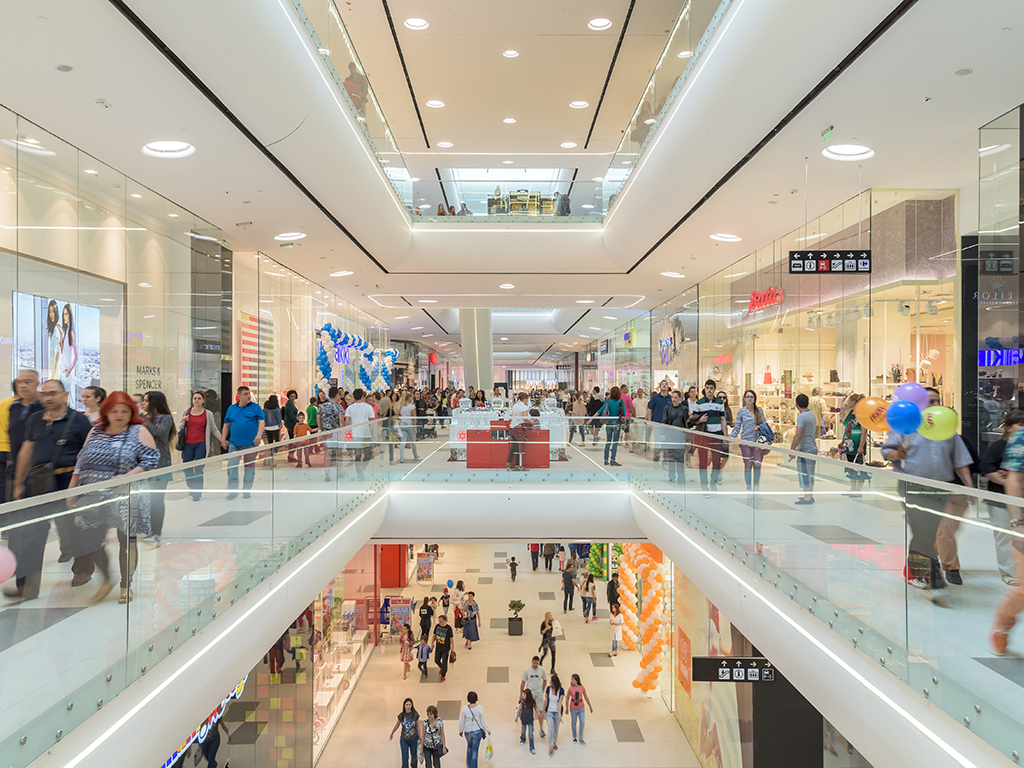Retail parks for “fair” business, shopping centers for big players – Is the retail market in Serbia becoming oversaturated?
The market in Serbia has been re-activated and there’s a rising demand for quality business premises, and big capital projects concerning shopping centers and retail parks are also in progress, it was agreed at the panel on shopping centers held within the recent REBEC (Real Estate Belgrade Exhibition and Conference) 2018.
– Investors are increasingly interested in our country – Mia Zecevic of Novaston Asset Management says for eKapija and adds that the fact that other markets in the region have become saturated has contributed to this.
According to the company’s data, 600,000 m2 of modern retail facilities have been built in Serbia in the past ten years, and new shopping centers and retail parks, amounting to an additional 300,000 m2, are being planned.
Delta City, Usce, Stadion, BIG Fashion, Rajiceva are only some of the modern shopping centers in Serbia.
According to Mia Zecevic, two shopping centers have opened in the past year and a half in Belgrade – Rajiceva and BIG Fashion – and another two are being constructed – BW Galerija and Ada Mall Shopping Center. Belgrade will thereby get a new 130,000 m2 of retail space by the end of 2020.
Furthermore, as said, the first big shopping center in Novi Sad, Promenada, will open by the end of 2018. It will provide 50,000 m2 of space for lease to world-renowned brands and other lessees.
The data of Novaston Asset Management also show that, since 2011, around twenty retail parks have opened, such as Aviv, Stop Shop, Capitol Park, Shoppi, Nest, whereas as many as 11 are planned for 2019.
– When this cycle ends, we are looking at a period of the “calming down” of the market, as it will take some time for the sudden increase in the supply to be absorbed. Looking at the experience of the countries in the region, it would be good for us to avoid the trap of oversaturation and to wait a bit after the first cycle before starting the next wave – Zecevic said.
That oversaturation can be a problem is also confirmed by Burc Korkmazlar, Europe Retail Director at the Turkish textile company Waikiki, who says that what made Serbia interesting to them was primarily the not-so-big competition.
– When we arrived to Serbia 7-8 years ago, I was surprised because, at the time, there were only 2-3 shopping centers in Belgrade. You could see the liveliness in the city and the need for a greater supply, but there was no competition. That’s why we couldn’t wait to enter this market – Korkmazlar said.
According to him, they do better business in Serbia than in the EU, although the opposite might be expected due to the greater purchasing power in those countries.
– Investors are increasingly interested in our country – Mia Zecevic of Novaston Asset Management says for eKapija and adds that the fact that other markets in the region have become saturated has contributed to this.
According to the company’s data, 600,000 m2 of modern retail facilities have been built in Serbia in the past ten years, and new shopping centers and retail parks, amounting to an additional 300,000 m2, are being planned.
Delta City, Usce, Stadion, BIG Fashion, Rajiceva are only some of the modern shopping centers in Serbia.
According to Mia Zecevic, two shopping centers have opened in the past year and a half in Belgrade – Rajiceva and BIG Fashion – and another two are being constructed – BW Galerija and Ada Mall Shopping Center. Belgrade will thereby get a new 130,000 m2 of retail space by the end of 2020.
Furthermore, as said, the first big shopping center in Novi Sad, Promenada, will open by the end of 2018. It will provide 50,000 m2 of space for lease to world-renowned brands and other lessees.
The data of Novaston Asset Management also show that, since 2011, around twenty retail parks have opened, such as Aviv, Stop Shop, Capitol Park, Shoppi, Nest, whereas as many as 11 are planned for 2019.
– When this cycle ends, we are looking at a period of the “calming down” of the market, as it will take some time for the sudden increase in the supply to be absorbed. Looking at the experience of the countries in the region, it would be good for us to avoid the trap of oversaturation and to wait a bit after the first cycle before starting the next wave – Zecevic said.
That oversaturation can be a problem is also confirmed by Burc Korkmazlar, Europe Retail Director at the Turkish textile company Waikiki, who says that what made Serbia interesting to them was primarily the not-so-big competition.
– When we arrived to Serbia 7-8 years ago, I was surprised because, at the time, there were only 2-3 shopping centers in Belgrade. You could see the liveliness in the city and the need for a greater supply, but there was no competition. That’s why we couldn’t wait to enter this market – Korkmazlar said.
According to him, they do better business in Serbia than in the EU, although the opposite might be expected due to the greater purchasing power in those countries.
Gerald Grull of Immofinanz and Arn Willems of GTC, who agree that “everything is functioning well – permits are obtained quickly, and good profit is realized as well”, also see a good perspective for their companies in Serbia.
Immofinanz is one of the biggest companies in Austria. In the Serbian retail market, it is present through several Stop Shop retail parks throughout the country.
– If you look at the West, there’s a lot of money there, but there’s also less demand – Grull said.
He explained that a concept such as a retail park is simpler and more suitable for Serbia.
So far, the company has opened six retail parks, and as he says, there are more projects waiting to be realized.
When it comes to the retail sector, Arn Willems of GTC sees development in two directions.
– You can visit retail parks by car, do your shopping and go, and this works very successfully in Serbia – Willems says.
On the other hand, he adds, there are shopping centers, where “you need to focus on the quality, both of the materials and the design, the lighting, as white shopping centers are increasingly popular”.
His estimate is that, similar to Croatia, where there are at least a dozen projects that have never been realized, not all planned shopping centers will be built in Serbia either, but the market will be oversaturated even with the Belgrade Waterfront, Promenada and Ada Mall projects alone.
Retail vs shopping center
Retail parks, unlike shopping centers, feature lower rent, which is often the reason they are chosen.
Immofinanz is one of the biggest companies in Austria. In the Serbian retail market, it is present through several Stop Shop retail parks throughout the country.
– If you look at the West, there’s a lot of money there, but there’s also less demand – Grull said.
He explained that a concept such as a retail park is simpler and more suitable for Serbia.
So far, the company has opened six retail parks, and as he says, there are more projects waiting to be realized.
When it comes to the retail sector, Arn Willems of GTC sees development in two directions.
– You can visit retail parks by car, do your shopping and go, and this works very successfully in Serbia – Willems says.
On the other hand, he adds, there are shopping centers, where “you need to focus on the quality, both of the materials and the design, the lighting, as white shopping centers are increasingly popular”.
His estimate is that, similar to Croatia, where there are at least a dozen projects that have never been realized, not all planned shopping centers will be built in Serbia either, but the market will be oversaturated even with the Belgrade Waterfront, Promenada and Ada Mall projects alone.
Retail vs shopping center
Retail parks, unlike shopping centers, feature lower rent, which is often the reason they are chosen.
Korkmazlar believes that the location is also among the more important factors and that “not all shopping centers feature the best design”, as well as that retail parks are “more fair”, as all players are equal under that model.
– Shopping centers sometimes have too many clients who come there to socialize. We are more efficient in retail parks – Korkmazlar explains.
On the other hand, Ventzislav Ognianov of the Polish footwear company CCC says that, to them, the difference between shopping centers and retail parks is big because they can show a lot more at shopping centers.
– We have a wide range of products, so we require big outlets, which is what shopping centers offer. Although rent is higher than in retail parks, a big and good-looking store will earn you plenty, so the rent is not a problem – he said.
For this reason, he added, they expect to open up to 30 stores in Serbia and Bulgaria in the upcoming period.
Vladimir Kraljacic of Fashion Company, which does business with over 30 brands and has 86 stores in the region (49 in Serbia), says that, in Serbia, they started off with monobrand stores and then entered the shopping center concept.
– We are using our multibrand stores as a testing arena in order to see if there’s potential for further expansion. We are operating in only four cities in Serbia, in Belgrade, Novi Sad, Kragujevac and Nis, and we will try to present Fashion Company within the Belgrade Waterfront shopping center on the biggest area so far, amounting to 1,200 m2 – Kraljacic said.
Online sale competing with retail centers
The interest in online shopping is growing at a considerable rate and with it the offer of goods on the internet. “Armchair shopping” therefore threatens to jeopardize the operations of companies that offer their goods in retail centers, and each new company fights for its place in the market in its own way.
One of the alternatives is online presence. CCC realizes 15% of its income through online sales, whereas Waikiki is trying to offer collections in its stores that can’t be found online.
Another thing that benefits outlets is the fact that today’s shopping centers offer much more than a place to purchase goods at. They also feature movie theaters, restaurants, cafes, playrooms and many other features unavailable online.
Jovana Simeunovic
– Shopping centers sometimes have too many clients who come there to socialize. We are more efficient in retail parks – Korkmazlar explains.
On the other hand, Ventzislav Ognianov of the Polish footwear company CCC says that, to them, the difference between shopping centers and retail parks is big because they can show a lot more at shopping centers.
– We have a wide range of products, so we require big outlets, which is what shopping centers offer. Although rent is higher than in retail parks, a big and good-looking store will earn you plenty, so the rent is not a problem – he said.
For this reason, he added, they expect to open up to 30 stores in Serbia and Bulgaria in the upcoming period.
Vladimir Kraljacic of Fashion Company, which does business with over 30 brands and has 86 stores in the region (49 in Serbia), says that, in Serbia, they started off with monobrand stores and then entered the shopping center concept.
– We are using our multibrand stores as a testing arena in order to see if there’s potential for further expansion. We are operating in only four cities in Serbia, in Belgrade, Novi Sad, Kragujevac and Nis, and we will try to present Fashion Company within the Belgrade Waterfront shopping center on the biggest area so far, amounting to 1,200 m2 – Kraljacic said.
Online sale competing with retail centers
The interest in online shopping is growing at a considerable rate and with it the offer of goods on the internet. “Armchair shopping” therefore threatens to jeopardize the operations of companies that offer their goods in retail centers, and each new company fights for its place in the market in its own way.
One of the alternatives is online presence. CCC realizes 15% of its income through online sales, whereas Waikiki is trying to offer collections in its stores that can’t be found online.
Another thing that benefits outlets is the fact that today’s shopping centers offer much more than a place to purchase goods at. They also feature movie theaters, restaurants, cafes, playrooms and many other features unavailable online.
Jovana Simeunovic
Companies:
Novaston d.o.o. Beograd
Delta City 67 d.o.o. Beograd
Ušće Shopping Center Beograd
Eurobau connect ag Beograd
CEE-BIG Management Beograd
ABD Beograd
Rajićeva šoping centar Beograd
Immofinanz Services d.o.o. Beograd
Fashion Company Beograd
Poseidon Serbia Beograd
LC WAIKIKI Retail RS Beograd
GTC Business Park Beograd
Tags:
Share:






Only logged-in users can comment.


 Izdanje Srbija
Izdanje Srbija Serbia Edition
Serbia Edition Serbische Ausgabe
Serbische Ausgabe Izdanje BiH
Izdanje BiH Izdanje Crna Gora
Izdanje Crna Gora









 LinkedIn
LinkedIn Copy link
Copy link




